light TOYOTA HIGHLANDER HYBRID 2017 XU50 / 3.G Quick Reference Guide
[x] Cancel search | Manufacturer: TOYOTA, Model Year: 2017, Model line: HIGHLANDER HYBRID, Model: TOYOTA HIGHLANDER HYBRID 2017 XU50 / 3.GPages: 52, PDF Size: 2.3 MB
Page 2 of 52
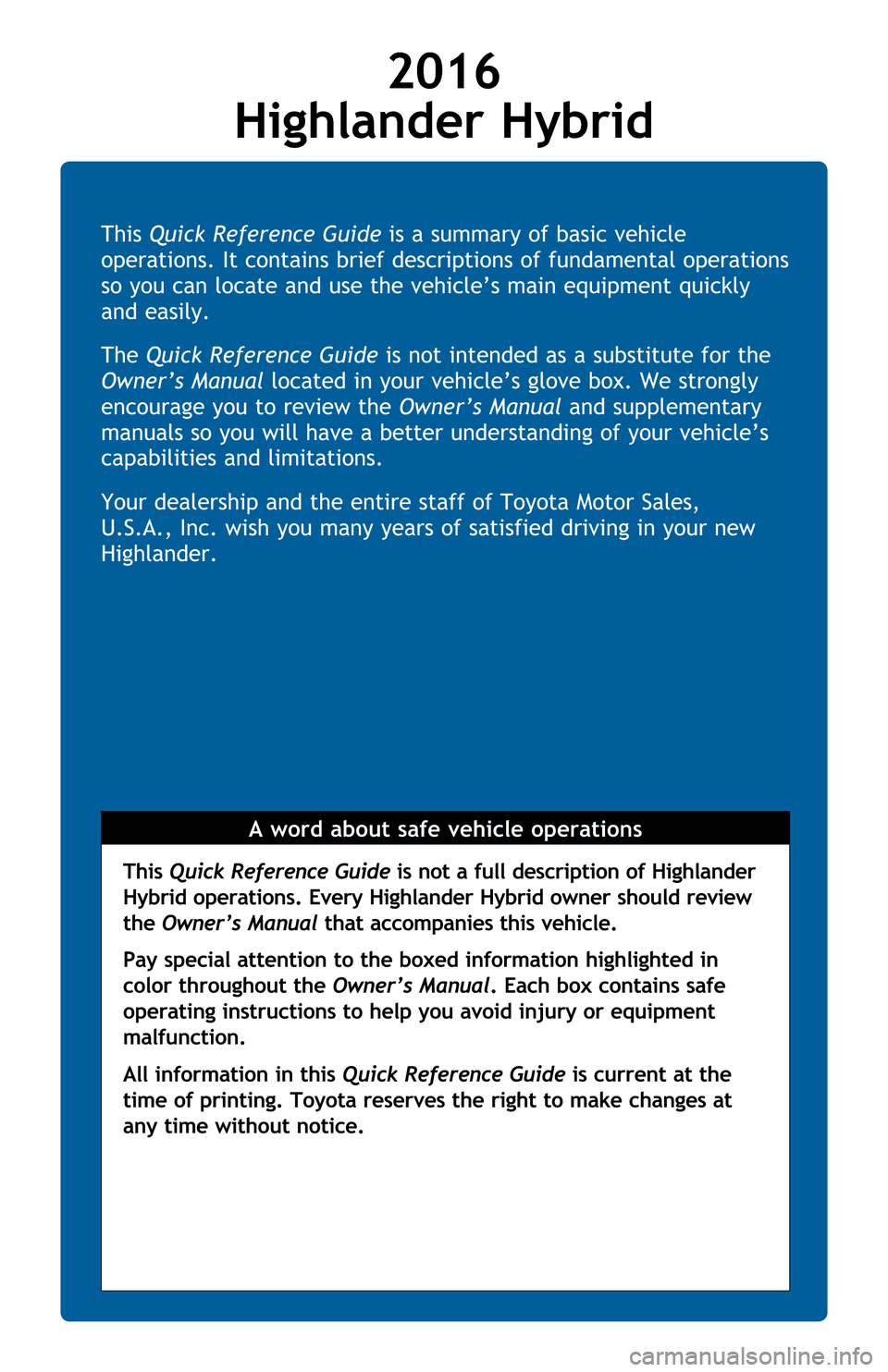
This Quick Reference Guide is a summary of basic vehicle
operations. It contains brief descriptions of fundamental operations
so you can locate and use the vehicle’s main equipment quickly
and easily.
The Quick Reference Guide is not intended as a substitute for the
Owner’s Manual located in your vehicle’s glove box. We strongly
encourage you to review the Owner’s Manual and supplementary
manuals so you will have a better understanding of your vehicle’s
capabilities and limitations.
Your dealership and the entire staff of Toyota Motor Sales,
U.S.A., Inc. wish you many years of satisfied driving in your new
Highlander.
A word about safe vehicle operations
This Quick Reference Guide is not a full description of Highlander
Hybrid operations. Every Highlander Hybrid owner should review
the Owner’s Manual that accompanies this vehicle.
Pay special attention to the boxed information highlighted in
color throughout the Owner’s Manual. Each box contains safe
operating instructions to help you avoid injury or equipment
malfunction.
All information in this Quick Reference Guide is current at the
time of printing. Toyota reserves the right to make changes at
any time without notice.
2016
Highlander Hybrid
Page 3 of 52
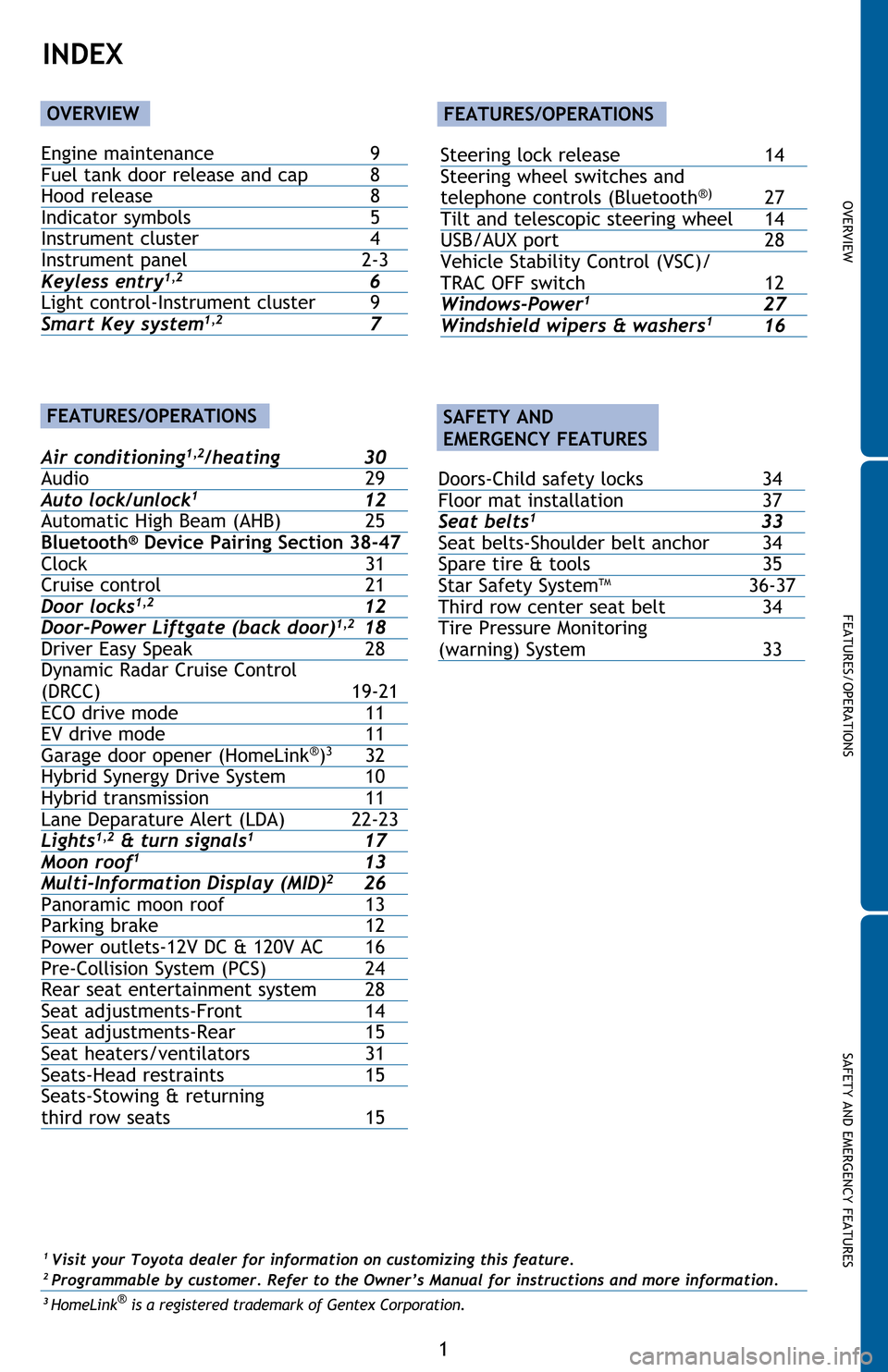
OVERVIEW
FEATURES/OPERATIONS
SAFETY AND EMERGENCY FEATURES
Engine maintenance 9
Fuel tank door release and cap 8
Hood release 8
Indicator symbols 5
Instrument cluster 4
Instrument panel 2-3
Keyless entry
1,2
6
Light control-Instrument cluster 9
Smart Key system
1,2
7
Air conditioning
1,2/heating 30
Audio 29
Auto lock/unlock
1 12
Automatic High Beam (AHB) 25
Bluetooth
® Device Pairing Section 38-47
Clock 31
Cruise control 21
Door locks
1,2 12
Door-Power Liftgate (back door)1,2 18
Driver Easy Speak 28
Dynamic Radar Cruise Control
(DRCC) 19-21
ECO drive mode 11
EV drive mode 11
Garage door opener (HomeLink
®)3
32
Hybrid Synergy Drive System 10
Hybrid transmission 11
Lane Deparature Alert (LDA) 22-23
Lights
1,2 & turn signals1 17
Moon roof1 13
Multi-Information Display (MID)2 26
Panoramic moon roof 13
Parking brake 12
Power outlets-12V DC & 120V AC 16
Pre-Collision System (PCS) 24
Rear seat entertainment system 28
Seat adjustments-Front 14
Seat adjustments-Rear 15
Seat heaters/ventilators 31
Seats-Head restraints 15
Seats-Stowing & returning
third row seats 15
1
INDEX
OVERVIEW
SAFETY AND
EMERGENCY FEATURESFEATURES/OPERATIONS
FEATURES/OPERATIONS
1 Visit your Toyota dealer for information on customizing this feature.2 Programmable by customer. Refer to the Owner’s Manual for instructions and more information.3 HomeLink® is a registered trademark of Gentex Corporation.
Doors-Child safety locks 34
Floor mat installation 37
Seat belts
1 33
Seat belts-Shoulder belt anchor 34
Spare tire & tools 35
Star Safety System
TM 36-37
Third row center seat belt 34
Tire Pressure Monitoring
(warning) System 33
Steering lock release 14
Steering wheel switches and
telephone controls (Bluetooth
®) 27
Tilt and telescopic steering wheel 14
USB/AUX port 28
Vehicle Stability Control (VSC)/
TRAC OFF switch 12
Windows-Power
1 27
Windshield wipers & washers1 16
Page 4 of 52

Telephone controls1
Audio remote control switches1
Voice command button1,2
Multi-Information Display (MID) control switches
Change displayed drive information “DISP” switch
Dynamic Radar Cruise Control (DRCC) vehicle-to-vehicle distance button
1
Dynamic Radar Cruise Control (DRCC)1 or Cruise control1 switch
Outside rear view mirror or rear window defogger button
Air conditioning controls
Headlight and turn signal controls/headlight, turn signal and front fog
light
1 controls
Instrument cluster
Wiper and washer controls
Emergency flasher button
Clock
Audio/navigation system
2,3
VSC OFF switch
ECO drive mode button
EV drive mode switch
1
Seat heater/ventilator switches1
2
OVERVIEW
Instrument panel
Steering wheel controls (if equipped)
Type A
Type B
Page 6 of 52
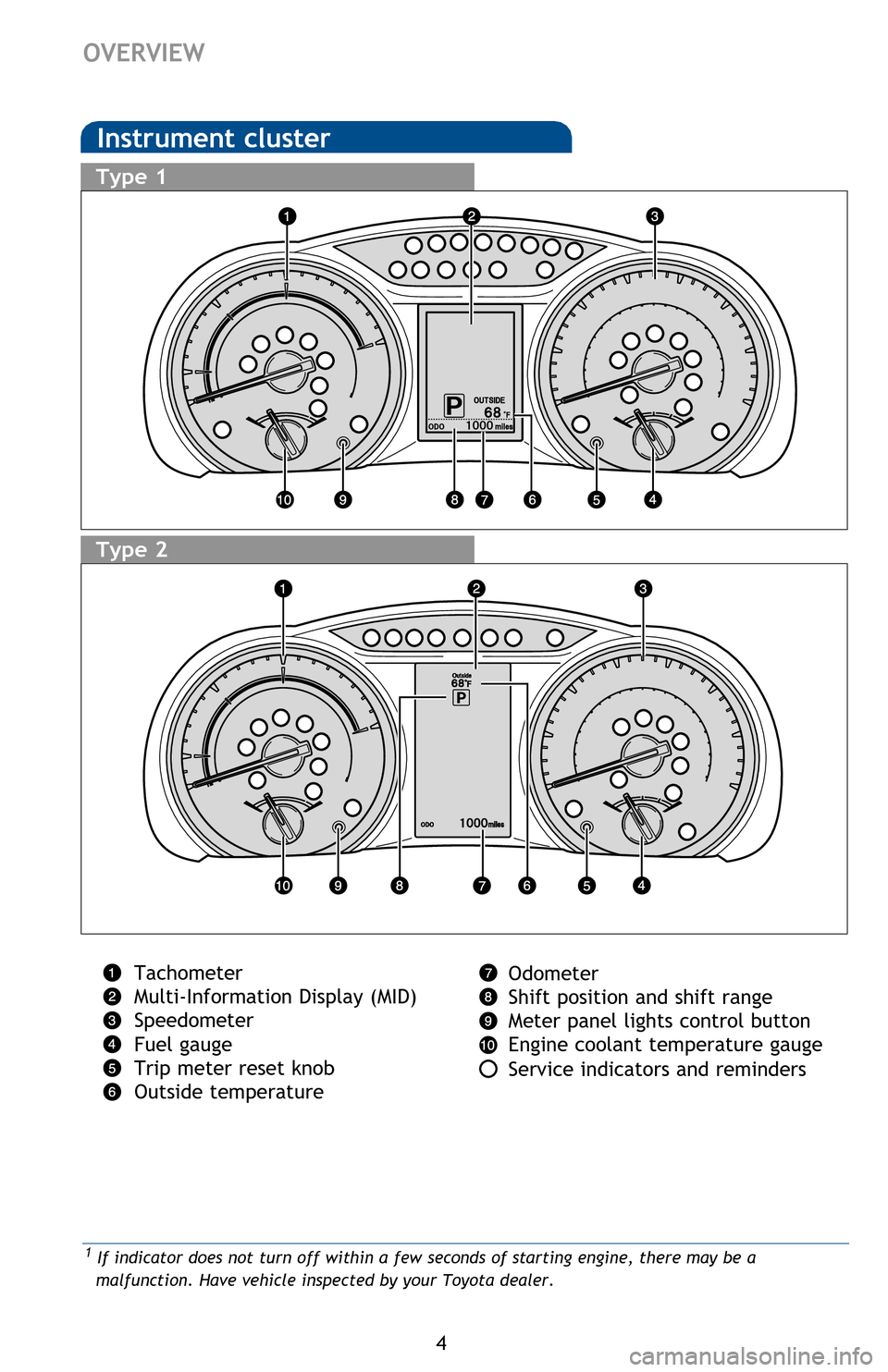
4
OVERVIEW
Indicator symbols Instrument cluster
2 If equipped1 If indicator does not turn off within a few seconds of starting engine, there may be a
malfunction. Have vehicle inspected by your Toyota dealer.
For details, refer to “Indicators and warning lights,” Section 2, 2016 Owner’s
Manual .
p. 98 meters
Type 1
Type 2
Odometer
Shift position and shift range
Meter panel lights control button
Engine coolant temperature gauge
Service indicators and reminders
Tachometer
Multi-Information Display (MID)
Speedometer
Fuel gauge
Trip meter reset knob
Outside temperature
134225_Highlander_QRG_GUTS.r2.indd 412/17/15 3:08 PM
Page 7 of 52

OVERVIEW
FEATURES/OPERATIONS
SAFETY AND EMERGENCY FEATURES
5
Indicator symbols
Charging system warning1,2
Brake system warning1
2 If equipped
Anti-lock Brake System warning1
Headlight low/high beam indicator Turn signal indicator
Vehicle Stability Control
OFF indicator1
SNOW mode indicator
Cruise control/Cruise control “SET” indicator2
Tire Pressure Warning1
Open door warning2
Airbag SRS warning1
Master warning1
Driver seat belt reminder
(alarm will sound if speed is over 12 mph)
Low engine oil pressure warning1,2
Malfunction/Check Engine
indicator1
Pre-collison warning
system indicator1
Low fuel level warning
Electric power steering
system warning1
Arrow direction indicates fuel
tank door position Blind Spot Monitor (BSM) outside
rear view indicator
2
Front fog light indicator2
Downhill Assist Control indicator2
Slip indicator1
For details, refer to “Indicators and warning lights,” Section 2, 2016 Owner’s
Manual.
Automatic High Beam (AHB) indicator2
Lane Departure Alert (LDA) indicator2
Intuitive parking assist indicator2
All-wheel drive lock indicator1,2
Security indicator1
Eco driving indicator1
Air Bag ON/OFF indicator1
Page 11 of 52

OVERVIEW
FEATURES/OPERATIONS
SAFETY AND EMERGENCY FEATURES
9 Windshield washer fluid tank
Engine oil level dipstick
Engine oil filler cap
Engine coolant reservoir
NOTE: Regularly scheduled maintenance, including oil changes, will help
extend the life of your vehicle and maintain performance. Please refer
to the “Warranty & Maintenance Guide.”
Engine maintenance
Light control-Instrument cluster
The brightness level of the meters
when the surroundings are bright
(day mode) and dark (night mode)
can be adjusted individually.
However,when in day mode,
adjusting the brightness level will
also change the brightness level of
night mode.
Page 12 of 52
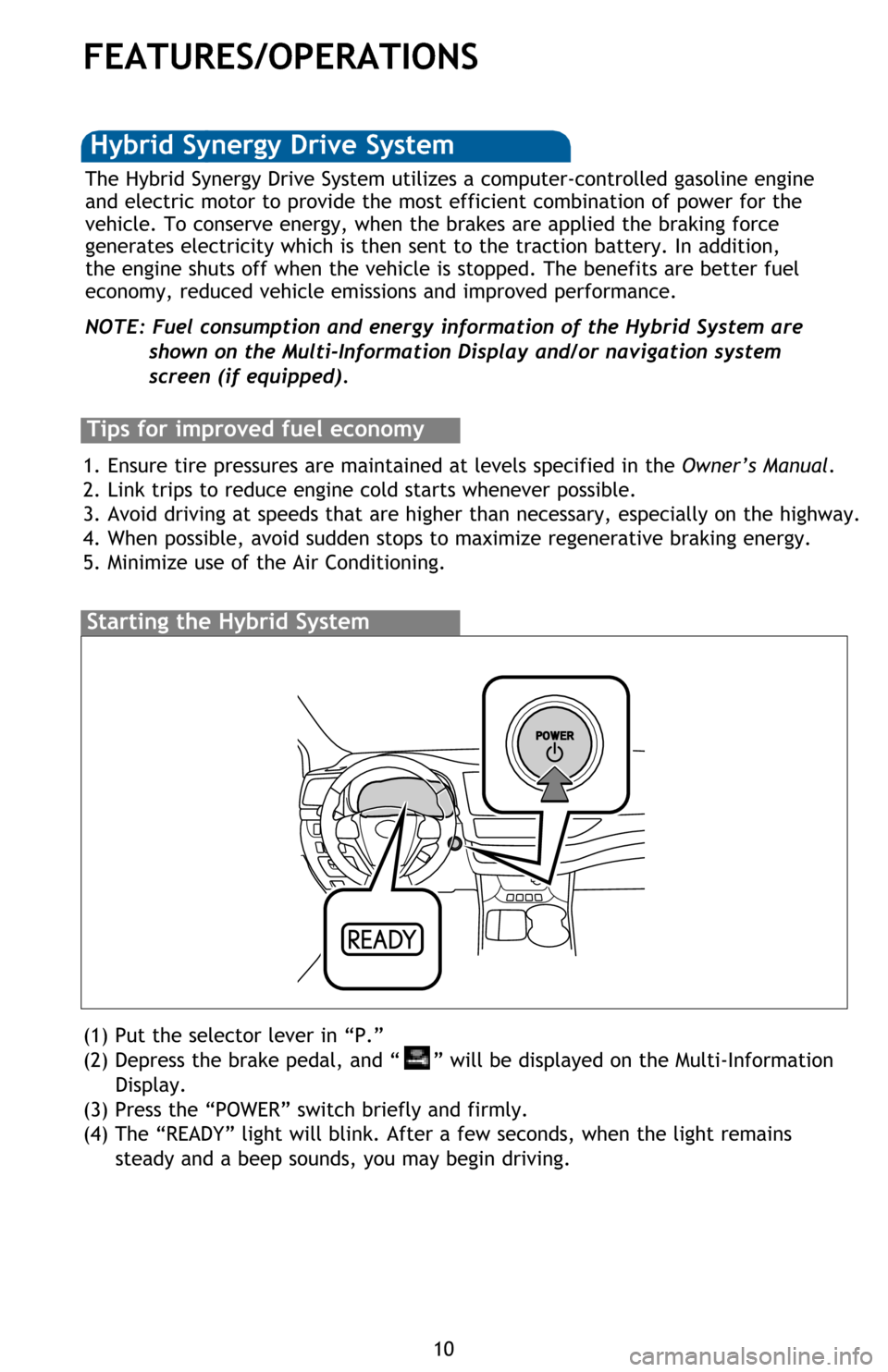
10
FEATURES/OPERATIONS
(1) Put the selector lever in “P.”
(2) Depress the brake pedal, and “
” will be displayed on the Multi-Information
Display.
(3) Press the “POWER” switch briefly and firmly.
(4) The “READY” light will blink. After a few seconds, when the light remains
steady and a beep sounds, you may begin driving.
Starting the Hybrid System
The Hybrid Synergy Drive System utilizes a computer-controlled gasoline engine
and electric motor to provide the most efficient combination of power for the
vehicle. To conserve energy, when the brakes are applied the braking force
generates electricity which is then sent to the traction battery. In addition,
the engine shuts off when the vehicle is stopped. The benefits are better fuel
economy, reduced vehicle emissions and improved performance.
NOTE: Fuel consumption and energy information of the Hybrid System are
shown on the Multi-Information Display and/or navigation system
screen (if equipped).
Tips for improved fuel economy
1. Ensure tire pressures are maintained at levels specified in the Owner’s Manual.
2. Link trips to reduce engine cold starts whenever possible.
3. Avoid driving at speeds that are higher than necessary, especially on the highway.
4. When possible, avoid sudden stops to maximize regenerative braking energy.
5. Minimize use of the Air Conditioning.
Hybrid Synergy Drive System
Page 15 of 52
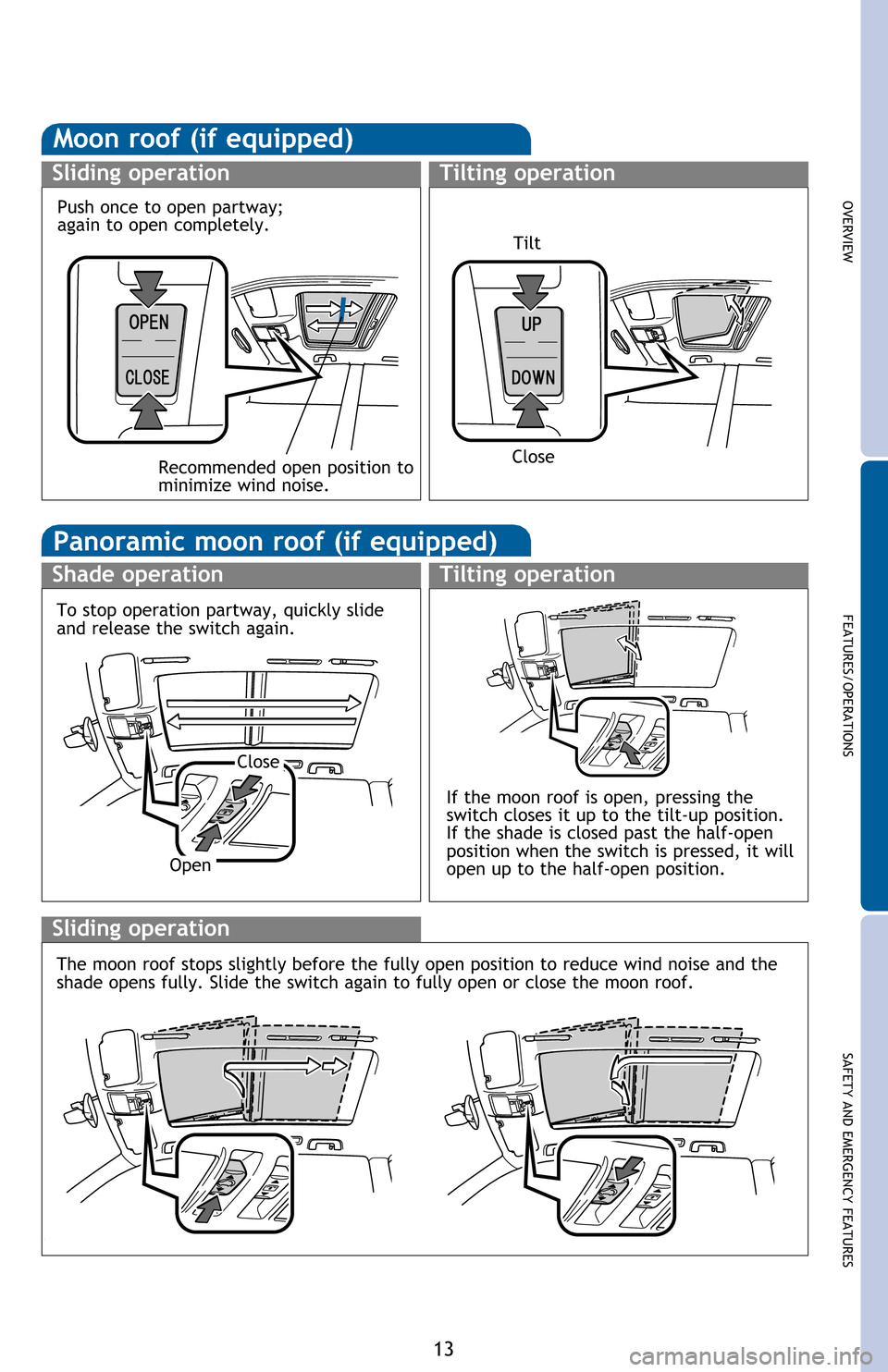
OVERVIEW
FEATURES/OPERATIONS
SAFETY AND EMERGENCY FEATURES
13
Moon roof (if equipped)
Sliding operationTilting operation
Tilt
Close
Recommended open position to
minimize wind noise. Push once to open partway;
again to open completely.
Panoramic moon roof (if equipped)
Shade operationTilting operation
If the moon roof is open, pressing the
switch closes it up to the tilt-up position.
If the shade is closed past the half-open
position when the switch is pressed, it will
open up to the half-open position. To stop operation partway, quickly slide
and release the switch again.
Close
Open
Sliding operation
The moon roof stops slightly before the fully open position to reduce wind noise and the
shade opens fully. Slide the switch again to fully open or close the moon roof.
Page 19 of 52
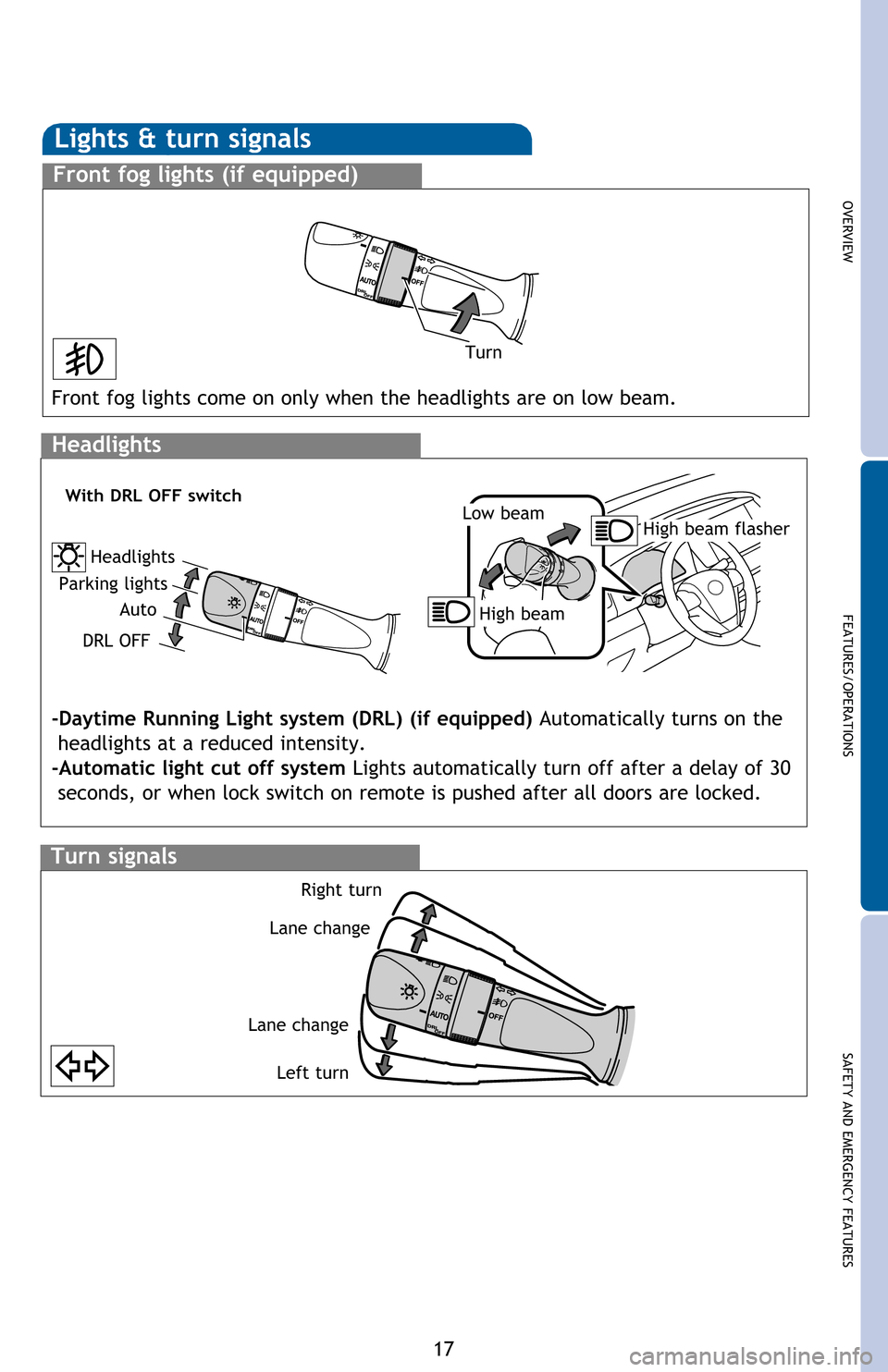
OVERVIEW
FEATURES/OPERATIONS
SAFETY AND EMERGENCY FEATURES
17
Lights & turn signals
Front fog lights (if equipped)
Front fog lights come on only when the headlights are on low beam.
Headlights
-Daytime Running Light system (DRL) (if equipped) Automatically turns on the
headlights at a reduced intensity.
-Automatic light cut off system Lights automatically turn off after a delay of 30
seconds, or when lock switch on remote is pushed after all doors are locked.
Low beam
High beam
High beam flasher
Parking lights
Auto
DRL OFF
With DRL OFF switch
Headlights
Turn
Turn signals
Right turn
Lane change
Lane change
Left turn
Page 22 of 52
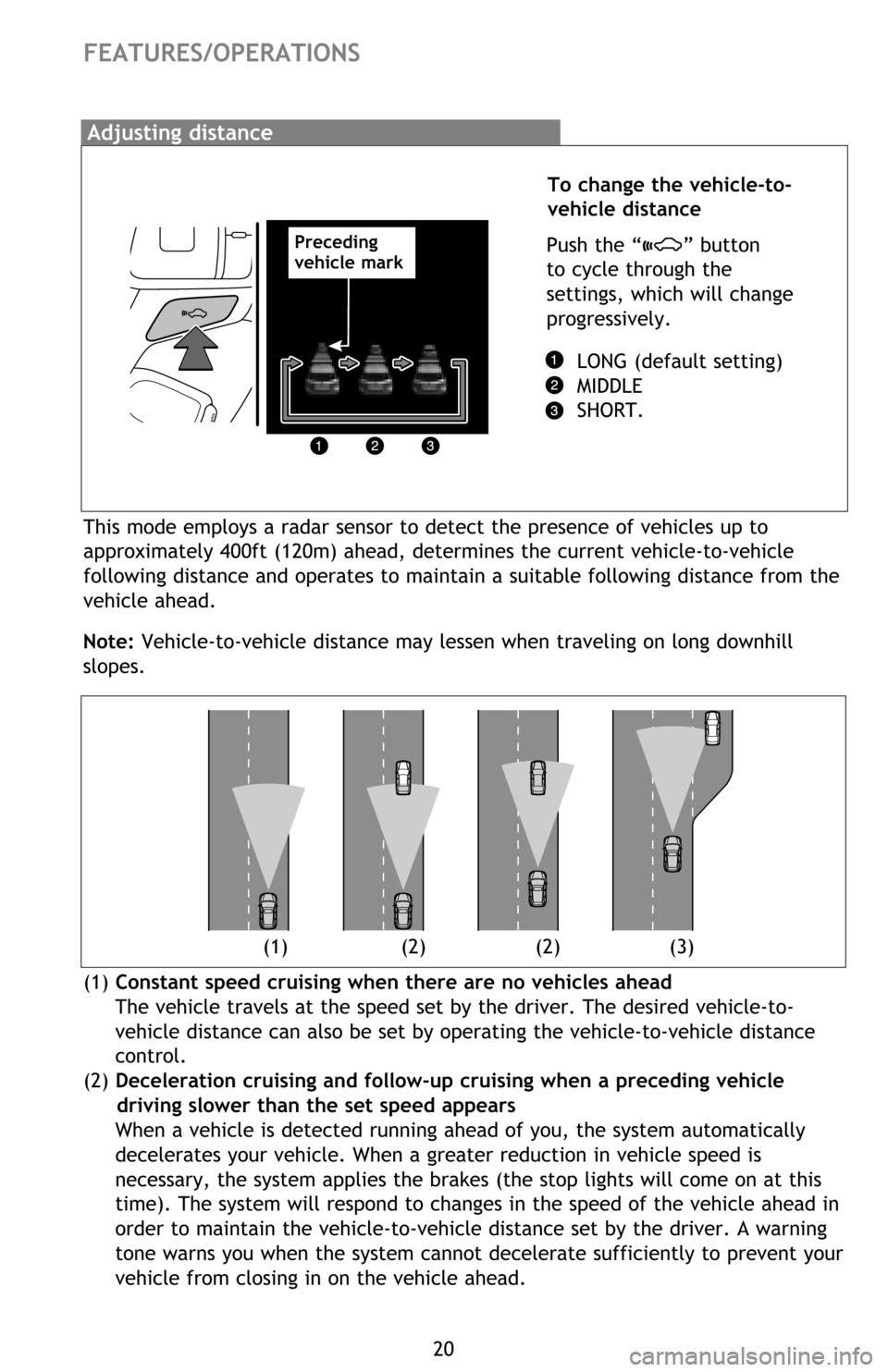
20
Adjusting distance
To change the vehicle-to-
vehicle distance
Push the “
” button
to cycle through the
settings, which will change
progressively.
LONG (default setting)
MIDDLE
SHORT.
This mode employs a radar sensor to detect the presence of vehicles up to
approximately 400ft (120m) ahead, determines the current vehicle-to-vehicle
following distance and operates to maintain a suitable following distance from the
vehicle ahead.
(1) Constant speed cruising when there are no vehicles ahead
The vehicle travels at the speed set by the driver. The desired vehicle-to-
vehicle distance can also be set by operating the vehicle-to-vehicle distance
control.
(2) Deceleration cruising and follow-up cruising when a preceding vehicle
driving slower than the set speed appears
When a vehicle is detected running ahead of you, the system automatically
decelerates your vehicle. When a greater reduction in vehicle speed is
necessary, the system applies the brakes (the stop lights will come on at this
time). The system will respond to changes in the speed of the vehicle ahead in
order to maintain the vehicle-to-vehicle distance set by the driver. A warning
tone warns you when the system cannot decelerate sufficiently to prevent your
vehicle from closing in on the vehicle ahead. Note: Vehicle-to-vehicle distance may lessen when traveling on long downhill
slopes.
(1) (2) (2) (3)
Preceding
vehicle mark
FEATURES/OPERATIONS